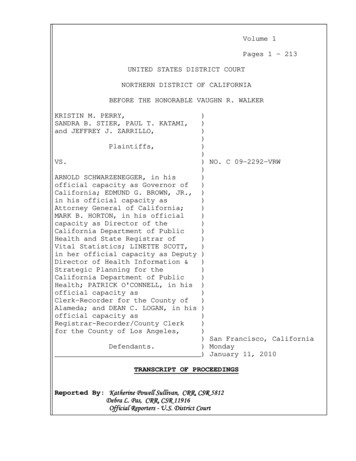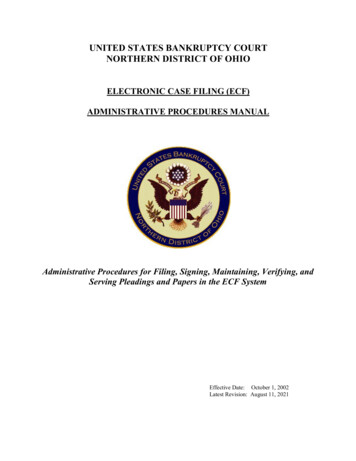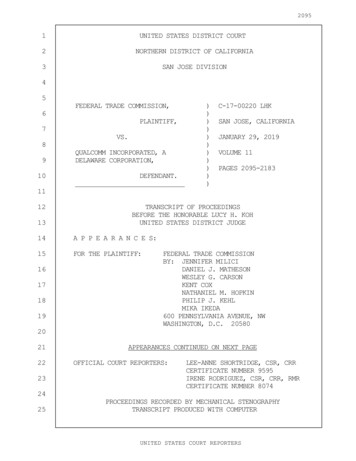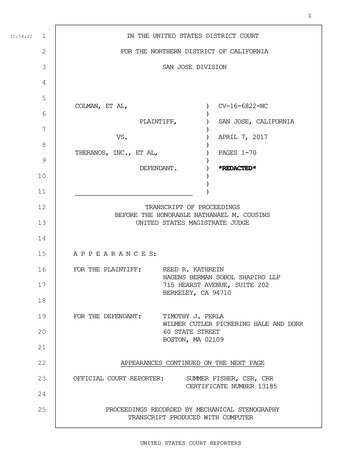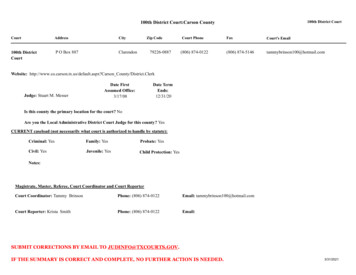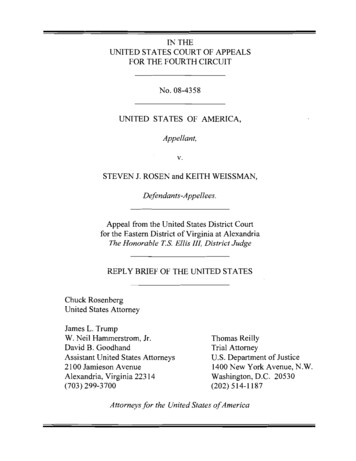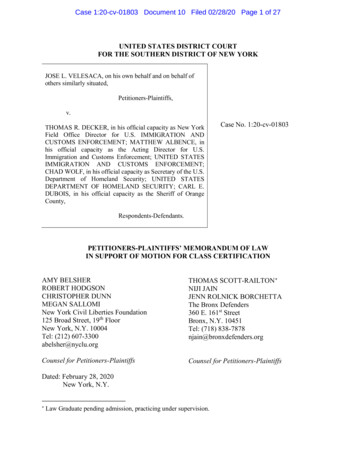
Transcription
Case 1:20-cv-01803 Document 10 Filed 02/28/20 Page 1 of 27UNITED STATES DISTRICT COURTFOR THE SOUTHERN DISTRICT OF NEW YORKJOSE L. VELESACA, on his own behalf and on behalf ofothers similarly situated,Petitioners-Plaintiffs,v.THOMAS R. DECKER, in his official capacity as New YorkField Office Director for U.S. IMMIGRATION ANDCUSTOMS ENFORCEMENT; MATTHEW ALBENCE, inhis official capacity as the Acting Director for U.S.Immigration and Customs Enforcement; UNITED STATESIMMIGRATION AND CUSTOMS ENFORCEMENT;CHAD WOLF, in his official capacity as Secretary of the U.S.Department of Homeland Security; UNITED STATESDEPARTMENT OF HOMELAND SECURITY; CARL E.DUBOIS, in his official capacity as the Sheriff of OrangeCounty,Case No. AINTIFFS’ MEMORANDUM OF LAWIN SUPPORT OF MOTION FOR CLASS CERTIFICATIONAMY BELSHERROBERT HODGSONCHRISTOPHER DUNNMEGAN SALLOMINew York Civil Liberties Foundation125 Broad Street, 19th FloorNew York, N.Y. 10004Tel: (212) 607-3300abelsher@nyclu.orgTHOMAS SCOTT-RAILTON NIJI JAINJENN ROLNICK BORCHETTAThe Bronx Defenders360 E. 161st StreetBronx, N.Y. 10451Tel: (718) 838-7878njain@bronxdefenders.orgCounsel for Petitioners-PlaintiffsCounsel for Petitioners-PlaintiffsDated: February 28, 2020New York, N.Y. Law Graduate pending admission, practicing under supervision.
Case 1:20-cv-01803 Document 10 Filed 02/28/20 Page 2 of 27TABLE OF CONTENTSTABLE OF AUTHORITIES . iiINTRODUCTION .1BACKGROUND .2ARGUMENT .11I.THE PROPOSED CLASS AND SUBCLASS SATISFY RULE 23(a). .13A. The Proposed Class and Subclass Are Sufficiently Numerous. .13B. Questions of Law and Fact Are Common to the Proposed Class andSubclass.15C. Mr. Velesaca’s Claims Are Typical of the Proposed Class andSubclass.18D. Mr. Velesaca Will Fairly And Adequately Represent the ProposedClass and Subclass. .19II.THE PROPOSED CLASS AND SUBCLASS SATISFY RULE 23(b)(2). .20III.PROPOSED CLASS COUNSEL ARE ADEQUATE UNDER RULE 23(g).21IV.THE PROPOSED CLASS AND SUBCLASS ALSO QUALIFY ASREPRESENTATIVE HABEAS CLASSES. .21CONCLUSION .23i
Case 1:20-cv-01803 Document 10 Filed 02/28/20 Page 3 of 27TABLE OF AUTHORITIESCasesAbdi v. Duke, 323 F.R.D. 131 (W.D.N.Y. 2017) . passimAbdi v. McAleenan, 405 F. Supp. 3d 467 (W.D.N.Y. 2019). .17Amchem Prods. Inc. v. Windsor, 521 U.S. 591 (1997) .17, 20Baffa v. Donaldson, Lufkin & Jenrette Secs. Corp, 222 F.3d 52 (2d Cir. 2000) .21Bertrand v. Sava, 535 F. Supp. 1020 (S.D.N.Y. 1982), rev’d on other grounds, 684F.2d 204 (2d Cir. 1982).12Brown v. Kelly, 609 F.3d 467 (2d Cir. 2010).16Brooklyn Center for Indep. of the Disabled v. Bloomberg, 290 F.R.D. 409 (S.D.N.Y.2012) .18Calderon v. Sessions, 330 F. Supp. 3d 944 (S.D.N.Y. 2018) .7Chief Goes Out v. Missoula County, 12-CV-155, 2013 WL 139938 (D. Mont. Jan. 10,2013) .14Clarkson v. Coughlin, 145 F.R.D. 339 (S.D.N.Y. 1993) .12Consol. Rail Corp. v. Town of Hyde Park, 47 F.3d 473 (2d Cir. 1995) .13Cutler v. Perales, 128 F.R.D. 39 (S.D.N.Y. 1989) .16Dean v. Coughlin, 107 F.R.D. 331 (S.D.N.Y. 1985 .15Denney v. Deutsche Bank AG, 443 F.3d 253 (2d Cir. 2006) .19Escalera v. N.Y.C. Hous. Auth., 425 F.2d 853 (2d Cir. 1970) .16Floyd v. City of New York, 283 F.R.D. 153 (S.D.N.Y. 2012) .16Gortat v. Capala Bros., Inc., 07-CV-3629, 2012 WL 1116495 (E.D.N.Y. Apr. 3,2012), aff’d, 568 Fed. Appx. 78 (2d Cir. 2014) .14In re Frontier Ins. Group, Inc., Sec. Litig., 172 F.R.D. 31 (E.D.N.Y. 1997) .19Jane B. by Martin v. New York City Dep’t of Soc. Servs., 117 F.R.D. 64 (S.D.N.Y.1987) .14Johnson v. Nextel Commc’ns Inc., 780 F.3d 128 (2d Cir. 2015) .15, 17ii
Case 1:20-cv-01803 Document 10 Filed 02/28/20 Page 4 of 27L.V.M. v. Lloyd, 318 F. Supp. 3d 601 (S.D.N.Y. 2018).12, 20Marisol A. v. Giuliani, 126 F.3d 372 (2d Cir. 1997) .12, 16, 20Odom v. Hazen Transp., Inc., 275 F.R.D. 400 (W.D.N.Y. 2011) .15Pennsylvania Pub. Sch. Employees’ Ret. Sys. v. Morgan Stanley & Co., 772 F.3d 111(2d Cir. 2014) .13Port Auth. Police Benevolent Ass’n v. Port Auth. of N.Y. & N.J., 698 F.2d 150 (2dCir. 1983) .16Robidoux v. Celani, 987 F.2d 931 (2d Cir. 1993) .13, 18Sumitomo Copper Litigation v. Credit Lyonnais Rouse, Ltd., 262 F.3d 134 (2d Cir.2001) .12United States ex rel. Sero v. Preiser, 506 F.2d 1115 (2d Cir. 1974), cert. denied, 95 S.Ct. 1587 (1975) .12, 21, 22V.W. by and through Williams v. Conway, 236 F. Supp. 3d 554 (N.D.N.Y. 2017).18, 20Wal-Mart Stores, Inc. v. Dukes, 564 U.S. 338 (2011) .15, 16, 20Statutes, Rules, and Regulations6 C.F.R. § 15.30 .2, 38 C.F.R. § 287.3(d) .38 C.F.R. § 1003.19(a).48 C.F.R. § 1236.1(c)(8) .38 U.S.C. § 1226(a) . passim29 U.S.C. § 794 .2, 3Fed. R. Civ. P. 23(a) . passimFed. R. Civ. P. 23(b)(2). passimFed. R. Civ. P. 23(g) .21iii
Case 1:20-cv-01803 Document 10 Filed 02/28/20 Page 5 of 27INTRODUCTIONThe petitioners move for class certification in this action challenging the unlawfuldetention of thousands of people arrested for civil immigration offenses in the New York Cityarea who by law are eligible for release. Within 48 hours of such arrests, Immigration andCustoms Enforcement (“ICE”) is required to make individualized assessments about whether torelease people they arrest on bond or recognizance during the pendency of their immigrationproceedings. Under their “No-Release Policy,” however, local ICE officials are not doingindividualized assessments and instead are denying release to virtually everyone, with the resultthat members of the putative class are incarcerated for weeks or even months before having ameaningful opportunity to seek release on bond before an Immigration Judge. During this time,they suffer loss of liberty, family separation, job loss, potential harm to their health, and acascading series of hardships flowing from the disruption to their life. The petitioners seekdeclaratory and injunctive relief striking down the No-Release Policy and guaranteeing putativeclass members the individualized assessment to which they are entitled.The proposed class (the “Petitioner Class”) consists of all individuals who have been, orwill be, arrested under Section 1226(a) of Title 8 of the United States Code by ICE’s New YorkField Office (“NYFO”) 1—in other words, all those arrested by ICE who are not subject tomandatory detention—and who have been or will be denied release on bond or recognizancepursuant to the No-Release Policy. The petitioner also moves to certify a proposed sub-classconsisting of all members of the Petitioner Class with disabilities as defined under theThe New York Field Office is responsible for immigration enforcement in New York City and thefollowing counties: Duchess, Nassau, Putnam, Suffolk, Sullivan, Orange, Rockland, Ulster, andWestchester.11
Case 1:20-cv-01803 Document 10 Filed 02/28/20 Page 6 of 27Rehabilitation Act and its implementing regulations (the “Rehabilitation Act Subclass”), 29U.S.C. § 794; 6 C.F.R. § 15.30.This case is plainly appropriate for class-wide adjudication. The proposed class consistsof a large and transient group of detained people who, by virtue of their indigence andincarceration, are hampered from bringing individual suits against the federal government. Thechallenged injury—the failure to provide an individualized assessment and subsequentdetention—is experienced by all class and subclass members and results from the same NoRelease Policy, and the remedy sought would apply to the entire class. The same is true for theproposed Rehabilitation Act Subclass, who all have disabilities, were denied an individualizeddetermination under the No-Release Policy, and are entitled to the same relief under theRehabilitation Act. Finally, proposed class counsel are qualified and experienced in class action,civil rights, and immigrants’ rights litigation. For all these reasons and other reasons set forthbelow class certification is the appropriate mechanism for achieving a just and efficientresolution of this litigation, and the petitioners respectfully request that the Court certify theproposed Petitioner Class and Rehabilitation Act Subclass.BACKGROUNDICE’s NYFO arrests several thousand people annually on civil immigration charges anddetains them for removal proceedings. See Declaration of David Hausman (“Hausman Decl.”) ¶14. Once arrested, people are initially processed at ICE offices in the Southern District of NewYork and, like Jose Velesaca, incarcerated thereafter at detention facilities in the greater NewYork City area while awaiting their first appearance in immigration court. See Declaration ofSarah Deri Oshiro (“Oshiro Decl.”) ¶¶ 7-8. Putative class and subclass members are detainedpursuant to Section 1226(a) of Title 8 of the United States Code (“Section 1226(a)”) while2
Case 1:20-cv-01803 Document 10 Filed 02/28/20 Page 7 of 27awaiting their first appearance in immigration court. Under the Immigration and Nationality Act(“INA”) and its implementing regulations, ICE, a subcomponent of the U.S. Department ofHomeland Security, serves as the arresting, jailing, and prosecuting agency in removalproceedings. As alleged below, the NYFO has adopted a policy or practice of unlawfullydenying putative class and subclass members the individualized assessment of their eligibility forbond or release to which they are entitled.ICE’s Initial Custody Determination ProcessPutative class and subclass members are eligible to be considered for release during thependency of their removal proceedings pursuant to Section 1226(a)(2), which provides that,“pending a decision on whether the alien is to be removed from the United States . . . TheAttorney General . . . may release the alien on . . . (A) bond of at least 1,500 . . . or (B)conditional parole.” 8 U.S.C. § 1226(a)(2). Implementing regulations delegate the AttorneyGeneral’s authority to grant bond or conditional parole to ICE officers, and, within 48 hours ofdetention, the officer must make a determination about the appropriateness of release based ontwo factors: whether “such release would not pose a danger to property or persons, and [whether]the alien is likely to appear for any future proceeding.” 8 C.F.R. § 1236.1(c)(8); see also 8C.F.R. § 287.3(d). These determinations must be individualized. See id. Additionally, ICEmust ensure it administers its activities consistently with federal protections for individuals withdisabilities under the Rehabilitation Act and the Department of Homeland Security’s ownimplementing regulations. See 29 U.S.C. § 794; 6 C.F.R. § 15.30.In 2013, ICE implemented an algorithmic risk classification assessment tool to assist itsofficers to make these initial custody determinations. See Robert Koulish, ImmigrationDetention in the Risk Classification Assessment Era at 6, Connecticut Public Interest Law3
Case 1:20-cv-01803 Document 10 Filed 02/28/20 Page 8 of 27Journal (Nov. 2016) (attached as Exhibit 1 to the Declaration of Robert Hodgson (“HodgsonDecl.”)). ICE officers input information about the arrested person into the tool, which wasoriginally programmed to generate one of four recommendations: (1) detain without bond, (2)detain with eligibility for bond, (3) defer the decision to the ICE supervisor, or (4) release. Id. at¶ 14. ICE officers and supervisors then determine whether to affirm or override thisrecommendation. Declaration of Assistant Field Office Director Yvette Tay-Taylor, ¶ 10,Vazquez-Perez v. Decker, No. 1:18-CV-10683 (Jan. 28, 2019), ECF No. 69 (attached as Exhibit2 to Hodgson Decl.).Anyone who is not released after an ICE arrest remains incarcerated at a minimum untiltheir first appearance before an Immigration Judge, at which point they may request a custodyredetermination from the immigration court. 8 C.F.R. § 1003.19(a). At the Varick StreetImmigration Court, where people detained by the NYFO appear, the average time between anarrest and initial hearing is several weeks; but such wait times fluctuate and as recently as late2018 the average wait time was nearly three months. See, e.g., Declaration of David Hausman,Vazquez-Perez v. Decker, No. 1:18-CV-10683 (Dec. 5, 2018), ECF No. 53-7 (attached as Exhibit19 to Hodgson Decl.).In addition, for most people these initial hearings do not offer a meaningful opportunityto apply for bond, especially for those who are not represented by counsel prior to the hearing.There are a number of reasons why this is. Assembling a bond application is factually andlegally complex, as well as time-intensive, almost always involving letters of support and aninitial application for immigration relief with supporting evidence. The government does notprovide people in detention with information about the materials they would need to submit for abond application nor how they might do so. For the many people who do not have counsel until4
Case 1:20-cv-01803 Document 10 Filed 02/28/20 Page 9 of 27this initial hearing, it is quite logistically difficult to collect the supporting materials necessary,some of which may be outside of the country, while being held in jail. Moreover, ICE often doesnot provide relevant evidence supporting its charges until the initial hearing. These hearings areheld by videoconference, which presents numerous challenges for the detained person’s ability tosubmit an application and participate in a bond hearing, as well as for a lawyer who has not beenable to meet with a client prior to the hearing. Finally, a significant number of people inimmigration detention speak little or no English, which is a further challenge to preparing thenecessary documents and participating in the hearing. See Oshiro Decl. ¶¶ 11-25.Approximately 40% of people in immigration detention appearing at the Varick StreetImmigration Court are ultimately released on bond because the court determines that they areneither a flight risk nor a danger to the community. See Immigration Court Bond Hearings andRelated Case Decisions through January 2020, TRAC Immigration (attached as Exhibit 3 toHodgson Decl.).ICE’s No-Release PolicyICE has adopted a policy or practice of not conducting individualized custodydeterminations and instead detaining virtually everyone regardless of whether they present aflight or safety risk or suffer from a disability. The adoption of this No-Release Policy followedthe agency’s manipulations of its risk-assessment tool. ICE began to radically alter its custodydetermination process in 2015, when it modified the tool’s algorithm so that it could no longerrecommend people be given the opportunity for release on bond. See Hausman Decl. ¶ 17. Inmid-2017, ICE similarly removed the tool’s ability to recommend the release of people on theirown recognizance. Id. ¶ 18. As a result, the algorithm can now only generate one substantiverecommendation: detention without bond. While ICE officers and supervisors ostensibly5
Case 1:20-cv-01803 Document 10 Filed 02/28/20 Page 10 of 27retained the ability to accept or reject the tool’s recommendations, in 2017 the NYFOimplemented a local policy to make final determinations that are consistent with the recalibratedtool and deny bond or release to virtually everyone it processes.Together, these changes result in people being detained at an astoundingly high rate;almost no one is released, even as the percentage of people arrested who have a criminal historyhas gone down. Pursuant to the No-Release Policy, ICE officers in the NYFO no longer conductindividualized custody determinations in favor of a blanket detention policy applying to allindividuals regardless of whether they satisfy the requirements for release. According to dataobtained by the New York Civil Liberties Union under the Freedom of Information Act, in thefirst nine months of 2019, ICE detained 98% of all people it arrested compared to 60% in 2014.Hausman Decl. ¶ 14. Indeed, the NYFO denies release even to people whom the risk assessmenttool has classified as a low risk of both flight and danger to the community (the “low-lowpopulation”). Id. ¶¶ 11-13. After the manipulation of the risk assessment tool in mid-2017, ICEhas detained about 97% of this low-low population. Id. ¶ 14. The result is that hundreds ofpeople for whom detention serves no legitimate purpose are being deprived of their liberty.Compounding the harms of the No-Release Policy, the Trump Administrationsimultaneously executed its “zero tolerance” policy, rescinding the Obama Administration’simmigration enforcement priorities—which focused on apprehending people with criminalhistories and those who present a national security, border security, or public safety threat—andstating that it would “no longer exempt classes or categories of removable aliens from potentialenforcement.” Memorandum from Sec. of Homeland Security John Kelly to U.S. ImmigrationOfficials (Feb. 20, 2017) at 2 (attached as Exhibit 4 to Hodgson Decl.). By the end of 2018, thenumber of people without criminal convictions arrested by ICE in the New York City area had6
Case 1:20-cv-01803 Document 10 Filed 02/28/20 Page 11 of 27skyrocketed by 414% compared to 2016. NYC Mayor’s Office of Immigrant Affairs, 2019 FactSheet: ICE Enforcement in New York City (attached as Exhibit 5 to Hodgson Decl.). Thepercentage of people without criminal convictions constituted an even larger portion of overallarrests in 2019: 36% versus 14% in 2016. NYC Mayor’s Office of Immigrant Affairs, 2020 FactSheet: ICE Enforcement in New York City at 2 (attached as Exhibit 6 to Hodgson Decl.).Consequently, the NYFO is now detaining record levels of people without considering them forrelease, large numbers of whom even ICE believes present no danger to the community or risk offlight. Id.Significant and Ongoing Harms of DetentionWithout an opportunity to be considered for release by ICE, putative class and subclassmembers languish in harsh jail conditions for weeks or months before they have any opportunityto challenge the necessity or legality of their incarceration. ICE’s NYFO generally detains andprocesses individuals at ICE offices in Manhattan, and then moves them to county jails inneighboring counties, Oshiro Decl. ¶¶ 6-7, under the continued custody and control of the ICENYFO. 2This period of confinement before someone can seek bond in immigration court inflictssignificant harm on putative class and subclass members and their families. See Dep’t. ofHomeland Security, Office of Inspector General, DHS OIG Inspection Cites Concerns WithDetainee Treatment and Care at ICE Detention Facilities (2017) (“OIG Report”) (reportinginvasive procedures, substandard care, long waits for medical care and hygiene products, andmistreatment in ICE detention facilities, e.g., indiscriminate strip searches and, in one case, aSee Calderon v. Sessions, 330 F. Supp. 3d 944 (S.D.N.Y. 2018) (people detained at Hudson County Jailremain in the legal custody of ICE because the jail “is merely providing service to ICE, pursuant to anInter-Governmental Service Agreement (‘IGSA’)” and “ICE is in complete control of detainees’admission and release”).27
Case 1:20-cv-01803 Document 10 Filed 02/28/20 Page 12 of 27multiday lockdown for sharing a cup of coffee) (attached as Exhibit 7 to Hodgson Decl.).Hudson County Jail, where many putative class and subclass members are held, reported sixinmate deaths between June 2017 and March 2018 alone, including four suicides. See MonsyAlvarado, After Latest Suicide, Hudson County Takes Steps to Terminate Jail’s MedicalProvider, northjersey.com, Mar. 26, 2018) (attached as Exhibit 8 to Hodgson Decl.). At BergenCounty Jail in 2019, a serious mumps outbreak resulted in the quarantine of dozens ofimmigration detainees. Stephen Rex Brown, ICE Jail in Bergen County Quarantined,nydailynews.com, Jun. 11, 2019 (attached as Exhibit 9 to Hodgson Decl.); Doug Criss, 6 Inmatesat a New Jersey Jail Came Down With The Mumps, cnn.com, June. 13, 2019 (attached as Exhibit10 to Hodgson Decl.), and the Essex County Correctional Facility was the subject of a recentDHS report documenting “serious issues relating to safety, security, and environmental healththat require ICE’s immediate attention,” DHS OIG, Issues Requiring Action at the Essex CountyCorrectional Facility at 2, Feb. 13, 2019 (attached as Exhibit 11 to Hodgson Decl.). There havebeen two inmate deaths at the Essex County Jail since 2018, and over sixty detained people havebeen placed on suicide watch since 2015. Joe Brandt, An Inmate Died at the Essex County Jail 4Days Ago, nj.com, Mar. 22, 2019 (attached as Exhibit 12 to Hodgson Decl.); Lea Ceasrine,Dozens of ICE Detainees Have Been Placed on Suicide Watch at 2, documentedny.com, Apr. 17,2019) (attached as Exhibit 13 to Hodgson Decl.).Detention is particularly harmful to people who need medical or mental health care. SeeAiling Justice: New Jersey Inadequate Healthcare, Indifference, and Indefinite Confinement inImmigration Detention, Human Rights First (Feb. 2018), at 1-2, 6-10 (attached as Exhibit 14 toHodgson Decl.). ICE’s New York-area facilities routinely deny people access to vital medicaland mental health treatment—including delays in vital surgeries, denials of lifesaving medication8
Case 1:20-cv-01803 Document 10 Filed 02/28/20 Page 13 of 27for people with epilepsy and cancer, failure to provide medically-required food to individualswith diabetes resulting in extreme detriment to their health, and refusal to provide basic mentalhealth care for people at risk of suicide—and the adverse effects of these denials continue longafter detention has ended and may be permanent. See id. These effects are not just physical andmental; unmet medical and mental health needs lead directly to people being unable toparticipate effectively in their removal proceedings and in bond applications before anImmigration Judge. See Deportation by Default: Mental Disability, Unfair Hearings, andIndefinite Detention in the US Immigration System, Human Rights Watch & ACLU (2010), at 4,25-31 (citing research suggesting that “US citizens, particularly those with mental disabilities,have ended up in ICE custody, and that an unknown number of legal permanent residents (LPRs)and asylum seekers with a lawful basis for remaining in the United States may have beenunfairly deported from the country because their mental disabilities made it impossible for themto effectively present their claims in court”) (attached as Exhibit 16 to Hodgson Decl.).Many people arrested under Section 1226 have lived in the U.S. for many years, andaccording to a recent report approximately half of those with cases in the New York Cityimmigration courts, like the putative class and subclass members here, are being kept from theirchildren while detained. See Jennifer Stave, et al., Evaluation of the New York ImmigrantFamily Unity Project: Assessing the Impact of Legal Representation on Family and CommunityUnity, Vera Institute of Justice (Nov. 2017) (“Vera Evaluation”) at 19-20 (reporting that, onaverage, indigent people represented through the NYC immigration public defender program hadbeen living in the U.S. for 16 years and that 47% of them had children living with them in theUnited States) (attached as Exhibit 17 to Hodgson Decl.). Two thirds of those identified in thesame report were employed at the time of their arrest, and many were the primary breadwinners9
Case 1:20-cv-01803 Document 10 Filed 02/28/20 Page 14 of 27for their families, see id. at 17. As long as they remain detained, they and their families aredenied that vital employment income.Obstacles to Class and Subclass Members’ Ability to Prosecute Individual LawsuitsPutative class and subclass members—people who have been or will be denied release onbond or recognizance pursuant to the No-Release Policy—face systemic barriers to vindicatingtheir right to an individualized ICE custody determination, which can occur only throughindividual habeas petitions filed in federal court. A significant percentage of putative class andsubclass members are unrepresented during the period of detention prior to their initialappearance, see Oshiro Decl. ¶¶ 10; Vera Evaluation at 17 n.34 (explaining that between 50%64% of individuals appearing at Varick Street were unrepresented prior to their first mastercalendar hearing), and a large percentage of people in immigration detention do not speak, read,or write English, see Vera Evaluation at 20 (stating that English is not primary language for 69%of people detained by the NYFO). And both ICE’s own internal memos and a report by theAmerican Civil Liberties Union estimate that around fifteen percent of people in ICE detentionhave mental health disabilities. Dana Priest & Amy Goldstein, Errors in Psychiatric Diagnosesand Drugs Plague Strained Immigration System, Wash. Post (May 13, 2008) (attached as Exhibit18 to Hodgson Decl.); Deportation by Default at 3.Putative Class and Subclass Representative Mr. VelesacaPutative class and subclass representative Mr. Velesaca is currently in the custody of theNYFO at the Orange County Correctional Facility. Declaration of Jose L. Velesaca (“VelesacaDecl.”) ¶ 2. ICE took custody of Mr. Velesaca on January 30, 2020. See id. ¶ 2. Like allmembers of the putative class, Mr. Velesaca did not receive an individualized ICE custodydetermination, did not have an opportunity to be considered for release on recognizance or on an10
Case 1:20-cv-01803 Document 10 Filed 02/28/20 Page 15 of 27ICE bond, and did not have the appropriateness of his continued detention considered by ICE inlight of his risk of flight, danger to the community, or special vulnerabilities such as a disability.Mr. Velesaca has lived in New York State for over a decade. Velesaca Decl. ¶ 1. He has twoyoung children who are U.S. citizens. Id. Several other members of Mr. Velesaca’s family arealso U.S. citizens or green
The Bronx Defenders . 360 E. 161st Street Bronx, N.Y. 10451 . Tel: (718) 838-7878 @bronxdefenders.org . Counsel for Petitioners-Plaintiffs Dated: February 28, 2020 . New York, N.Y. Law Graduate pending admission, practicing under supervision. Case 1:20-cv-01803 Document 10 Filed 02/28/20 Page 1 of 27

